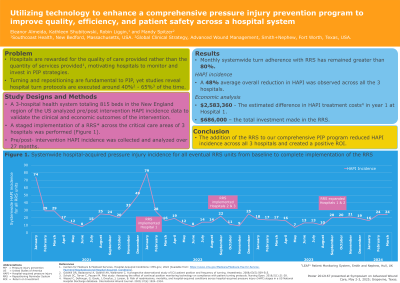Practice Innovations
(PI-001) Utilizing Technology to Enhance a Comprehensive Pressure Injury Prevention Program to Improve Quality, Efficiency, and Patient Safety Across a Hospital System
Friday, May 2, 2025
7:45 PM - 8:45 PM East Coast USA Time

Kathleen Shubitowski, MSN, RN, NPD-BC, CEN; Robin Liggin, BA; Mandy Spitzer, MBA, RN, CWOCN, CFCN
Introduction: The Center for Medicare & Medicaid Services rewards hospitals for the quality of care provided rather than the quantity of services provided1, motivating hospitals to monitor and invest in pressure injury prevention (PIP) strategies. Turning and repositioning are fundamental to PIP, and prior studies reveal turn protocols are adhered to between 42%2 - 66%3 of the time.
The aim of this analysis was to evaluate the influence of technology on improving adherence to PIP protocols.
Methods: A 3-hospital system with an established PIP protocol, which included a skin care regimen and preventive foam dressings, analyzed hospital-acquired pressure injury (HAPI) incidence data. The data was used to evaluate the pre- and post- incidence outcomes for all areas which implemented a repositioning reminder system (RRS) and excluded Stage 1 and mucosal membrane pressure injuries.
Results: Hospital 1 implemented the RRS in the intensive care unit (ICU) in January 2022. Comparing the baseline data from calendar year (CY) 2021 to CY 2022 revealed a 44.69% reduction in HAPI incidence in units where the RRS was implemented and an average adherence to turn protocols of 83% for all patients monitored by the RRS. Subtracting the financial investment in the RRS from the estimated pre- and post- HAPI treatment costs4 revealed a greater than 2 million USD return on investment in CY 2022.
Discussion: The reduction in HAPI incidence combined with the positive return on investment supported a systemwide expansion of the RRS and standardization of PIP protocols. Hospital 2 and 3 implemented the RRS in ICUs in September 2022, and Hospitals 1 and 2 expanded the RRS to the progressive care units in September 2023.
The aim of this analysis was to evaluate the influence of technology on improving adherence to PIP protocols.
Methods: A 3-hospital system with an established PIP protocol, which included a skin care regimen and preventive foam dressings, analyzed hospital-acquired pressure injury (HAPI) incidence data. The data was used to evaluate the pre- and post- incidence outcomes for all areas which implemented a repositioning reminder system (RRS) and excluded Stage 1 and mucosal membrane pressure injuries.
Results: Hospital 1 implemented the RRS in the intensive care unit (ICU) in January 2022. Comparing the baseline data from calendar year (CY) 2021 to CY 2022 revealed a 44.69% reduction in HAPI incidence in units where the RRS was implemented and an average adherence to turn protocols of 83% for all patients monitored by the RRS. Subtracting the financial investment in the RRS from the estimated pre- and post- HAPI treatment costs4 revealed a greater than 2 million USD return on investment in CY 2022.
Discussion: The reduction in HAPI incidence combined with the positive return on investment supported a systemwide expansion of the RRS and standardization of PIP protocols. Hospital 2 and 3 implemented the RRS in ICUs in September 2022, and Hospitals 1 and 2 expanded the RRS to the progressive care units in September 2023.

.jpg)